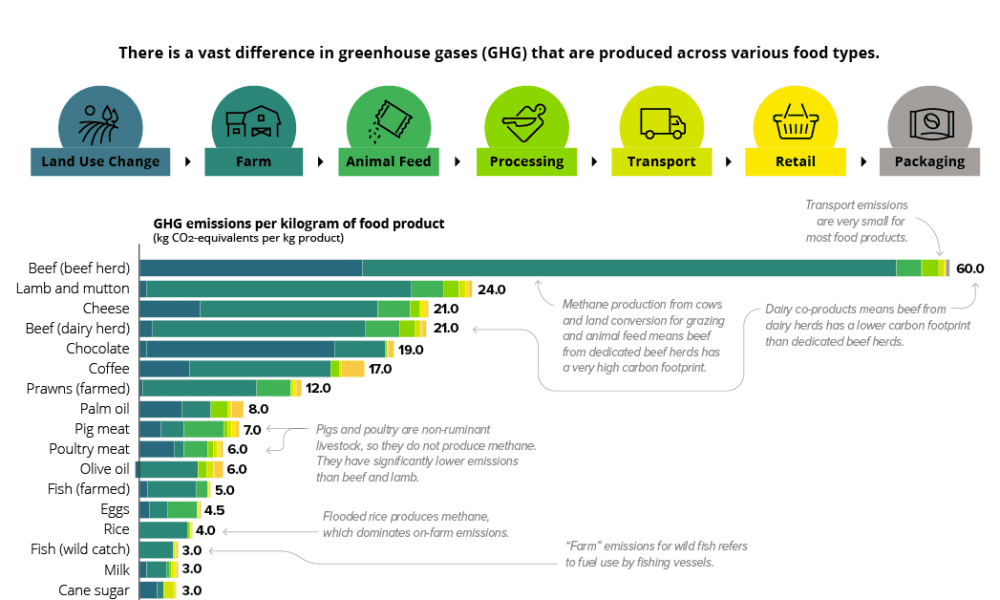Celebrating 50 Years of Earth Day: Simple Lifestyle Changes You Can Make to Help the Environment
April 27, 2020
On April 22, 1970, Senator Gaylord Nelson of Wisconsin held the first Earth Day celebration. He was appalled that such a crucially important and widely shared issue as the health of the environment was not being addressed in politics or the media. Nelson believed that creating a day of national recognition could change that.
Today, 50 years later, we hear much more about the environment in the media and politics; but the same issues that plagued the environment 50 years ago are still just as prevalent today, if not worse in many aspects. The ice caps are melting, the ocean is acidifying, the rainforests are burning, the deserts are spreading . . . and so on.
In honor of Nelson’s dream, we commemorate Earth Day of 2020 by sharing with you some simple ways you can alter your lifestyle to make a positive difference for the earth.
Change how you eat
We all know about carbon footprints. Animals take in oxygen and produce carbon dioxide, plants take in the carbon dioxide and produce oxygen — the carbon cycle, in its simplest terms. Almost everything you do has a carbon footprint, from microwaving a plate of nachos to driving to the supermarket. But did you know that between the many types of food you eat there is a very, very different size carbon footprint? Take a look at this graph:

(Image: https://www.visualcapitalist.com/visualising-the-greenhouse-gas-impact-of-each-food/)
Every food that is farmed or raised has an impact: the land it takes up that reduces space for trees to take in carbon dioxide, the water and nutrients it takes to grow, the fossil fuels used in processing and shipping. Some crops, like rice, take less energy and space and thus have a relatively small footprint. Other products, like coffee and chocolate, are more intensive and have a greater impact. But what has the most negative impact of anything is livestock. Now, I’m not going to tell you to go vegetarian, but let me take the soapbox for a minute.
Chicken is all right because it doesn’t have too huge of a carbon footprint, and pigs are a little worse but okay as well. The true culprit here is cows. Not only do they produce abhorrent amounts of methane, but the sheer quantity of land required to house them and grow their food is astronomical compared to any other meat. So, if you’re torn between your loves of meat and Mother Earth, I’ll advise a compromise — if nothing else, cut back on the beef. The Chick-Fil-A cow was right all along: eat more chicken.
Watch your energy use
You heard it every year on Earth Day in elementary school: turn off the lights when you don’t need them, turn off the sink while brushing your teeth, take shorter showers, etc. These habits may seem minor in themselves, but it’s still a difference and it starts with you.
Do you remember when Disney Channel used to air those ads where their actors told you to switch from incandescent light bulbs to fluorescents? Because I do. And they were right.

(Image: https://www.inlineelectric.com/energy_cost)
Fluorescent bulbs and LEDs are, without a doubt, vastly superior to their incandescent and halogen counterparts. Not only do you save money with their higher efficiency and longer lifespan, but they also help with your electric bill and reduce your natural gas usage. Boy, do I sound like an infomercial right now.
Beyond light bulbs, almost half of the average home’s energy usage comes from its heating and cooling. So when you can tolerate it, turn down the AC in the summer and turn on a fan instead. Dress warmer and huddle up in a blanket with some hot tea in the winter instead of cranking up the heater.
We found a lovely infographic that describes the major sources of energy use (and waste) in the average home, but it’s very long — not just detailed, but very vertically challenging — so we will include it at the end.
Reduce your consumption
We live in a consumerist society — that’s just the way it is. We find happiness in the material things like clothes, electronics, and those mood rings you get at the fair and lose in a drawer the next week. But the materials economy — of resource extraction, production, distribution, consumption, and disposal — takes a heavy toll on the environment where we acquire those resources.
In the last few decades, 1/3 of our natural resources have been trashed. Two thousand trees are being lost in the Amazon each minute. We would need three planet Earths to continue to support the current rates of consumption in the U.S. and Australia.
Do you ever wonder how a product can be so cheap — for example, a pair of $9.99 earbuds? That’s because of the external costs that aren’t included in the price tag: the underpaid factory workers, the people who sell the product that don’t receive health insurance, the people who lost their homeland to provide the natural resources and went uncompensated. Products aren’t made by magic. It’s a give-and-take economy, and for whatever you take, someone else is giving. (“The Story of Stuff” Project, https://www.youtube.com/watch?v=9GorqroigqM)
You don’t need to become a total minimalist or live as a hermit in the mountains to reduce your consumption. Purchase less and purchase wisely: look for a Fair Trade seal to ensure fair wages and working conditions for laborers, organic labels to promote agriculturally sustainable practices, or “Made in the USA” to reduce greenhouse emissions in overseas shipping.
We hope you learned a thing or two about promoting good habits for the environment. In summary: eat less beef, change your light bulbs, and buy for Fair Trade. Happy Earth Day!
Here’s the infographic we promised:

(Image: https://www.visualcapitalist.com/what-uses-the-most-energy-home/)

Thomas Peri • Apr 28, 2020 at 7:31 am
Thank you Elizabeth! Well done.